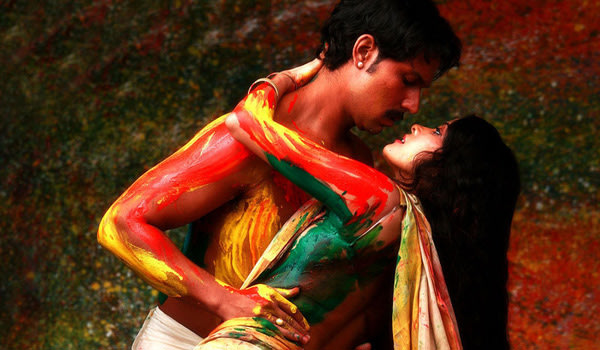In the wake of Ketan Mehta's RANG RASIYA winning the Audience Prize at the London Indian Film Festival, the issue of nudity in cinema surfaces once again. Made in 2008, the film is yet to be released in India reflecting the ambivalent attitude of the Censor Board towards nudity in films.
Clothing did not evolve merely to mask a particular part of the body. Across the international spectrum, there are conspicuous inconsistencies about which parts of the body people elect to cover, if they choose any part at all. In some places, the feet are to be covered for the sake of modesty. In other places, women's lips are believed to be so seductive that wearing veils in public is imperative.
Everywhere, customs and traditions symbolically confirm human uniqueness in the biological world. Some maintain this dichotomy by equating public nudity with bestiality. But things are changing. Over the last 10 years, the Indian audience, specially the Y generation, has developed a liberal approach towards body display in films, though not so much on television except on the news channels that generously display clippings from Indian films with partially clothed men and women. But public display of the human form with minimum or no clothing still evokes disgust and ridicule making viewers feel uncomfortable.
But the private, in some sense intimate and dark interiors of a theatre hall, strips us of our socially conditioned inhibitions. Filmmakers bank on this voyeuristic trait and insert scenes in their films based on the viewer being absolved of a sense of guilt while watching what he/she apparently should not watch. Indian filmmakers are testing the waters of morality that is forever in a state of flux. Live-in relationships and pre-marital sex are out in the open while homosexuality is now talked about as alternative sexual orientation. Yet, revealing of the barest essentials, especially in case of the female, remains a big no-no.
The problem with nudity - partial or entire - in Indian cinema is that the aesthetics of beauty is not considered even when a film like RANG RASIYA presents it as an element essential to the content. The film is the story of the once severely criticised painter Raja Ravi Verma (1848-1906) who painted without inhibition though he was distanced from the late M.F. Husain by nearly a century. The film has been adapted from the Marathi biographical novel Raja Ravi Varma by Ranjit Desai. Ironically, Raja Ravi Varma is not famous for painting women in the nude. He is renowned for his paintings of mythological women wearing the sari. Many of his paintings, however, display the women in white translucent saris that reveal more than they conceal, proving his belief in the artist's freedom of expression.
The film is about the painter's deep involvement with his muse, Sugandha portrayed by Nandana Sen who, incidentally, is a Harvard graduate, daughter of Nobel Laureate Amartya Sen and renowned litterateur and academic Nabaneeta Deb Sen. "I had to expose for a few scenes in this film but I consented because I felt that the scenes were integral to the context of the story and the character and was executed extremely well. It was not an easy decision for me but by the time the shots were taken, I had made myself thoroughly comfortable," says Nandana. One wide angle shot shows a bare breast of a skimpily clad Sen who did a similar scene in TANGO CHARLIE some years ago.
On the other hand, the aesthetics of nudity gets a short shrift in the world of Indian advertising and films. Calendars bank on skimpily clad beautiful women to make a fashion statement. Was the Madhu Sapre-Milind Soman embrace in the buff with a serpent coiled around their seemingly writhing bodies aesthetic? Or was it meant to titillate and attract both male and female viewers? Was Mandakini's shower bath under the waterfalls wearing a transparent white sari in Raj Kapoor's RAM TERI GANGA MAILI necessary to the form and content of the film? It was aimed at the box office and it hit the target right on. What kind of 'aesthetics' did we discover in Bipasha Basu's slow walking out of the waves of the sea barely clothed in Jism that made her famous overnight?
In a recent tribute to the late M.F. Husain, economist Ashok Mitra in an article in the popular newspaper commented on the tragedy of a painter being thrown out of his home country for having painted the Goddess Saraswati in the nude while crowds of Indian and international tourists continue queue up to ogle at the frescoes of Khajuraho (built around the 10th and 11th Century A.D.), Ajanta and Ellora in the country that is famous for Vatsayana's Kamasutra. The present form of the text was compiled in the second century BC. These heritage frescoes generously display well-endowed, voluptuous women, whose breasts are covered only with heavy jewellery.
Conrad Rook's SIDDHARTHA (1972) based on Herman Hesse's novel of the same name shot by Sven Nykvist starred Shashi Kapoor and Simi Garewal. It was about the young Siddhartha, born into aristocracy who sets out in search of the true meaning of life and wanders through the worlds of harsh asceticism, sensual pleasures and the like. Simi Garewal plays his sensual consort and is shown wearing only jewellery to cover her body. This created a furor in the Censor Board at that time because in those days, kissing too was not permitted on screen. Garewal reportedly took the case to court claiming that she was wearing something under loads of jewellery. She reportedly lost which is a pity. The Indian audience missed out on one of the most brilliantly cinematographed nude scenes on an Indian story shot by one of the best cameramen the world has ever produced.
Attitudes toward nudity may change dramatically from one generation to another within the same society. Though the Central Board of Film Certification raised issues about Nandana Sen's scenes in RANG RASIYA, Hindi films with their item songs that reveal expanses of thigh and cleavage in hip swinging and cleavage heaving gestures performed to bawdy lyrics cheerfully entertain the new generation audience in films -and approved by the Censor Board. Anyone wants to talk about aesthetics?
Clothing did not evolve merely to mask a particular part of the body. Across the international spectrum, there are conspicuous inconsistencies about which parts of the body people elect to cover, if they choose any part at all. In some places, the feet are to be covered for the sake of modesty. In other places, women's lips are believed to be so seductive that wearing veils in public is imperative.
Everywhere, customs and traditions symbolically confirm human uniqueness in the biological world. Some maintain this dichotomy by equating public nudity with bestiality. But things are changing. Over the last 10 years, the Indian audience, specially the Y generation, has developed a liberal approach towards body display in films, though not so much on television except on the news channels that generously display clippings from Indian films with partially clothed men and women. But public display of the human form with minimum or no clothing still evokes disgust and ridicule making viewers feel uncomfortable.
But the private, in some sense intimate and dark interiors of a theatre hall, strips us of our socially conditioned inhibitions. Filmmakers bank on this voyeuristic trait and insert scenes in their films based on the viewer being absolved of a sense of guilt while watching what he/she apparently should not watch. Indian filmmakers are testing the waters of morality that is forever in a state of flux. Live-in relationships and pre-marital sex are out in the open while homosexuality is now talked about as alternative sexual orientation. Yet, revealing of the barest essentials, especially in case of the female, remains a big no-no.
The problem with nudity - partial or entire - in Indian cinema is that the aesthetics of beauty is not considered even when a film like RANG RASIYA presents it as an element essential to the content. The film is the story of the once severely criticised painter Raja Ravi Verma (1848-1906) who painted without inhibition though he was distanced from the late M.F. Husain by nearly a century. The film has been adapted from the Marathi biographical novel Raja Ravi Varma by Ranjit Desai. Ironically, Raja Ravi Varma is not famous for painting women in the nude. He is renowned for his paintings of mythological women wearing the sari. Many of his paintings, however, display the women in white translucent saris that reveal more than they conceal, proving his belief in the artist's freedom of expression.
The film is about the painter's deep involvement with his muse, Sugandha portrayed by Nandana Sen who, incidentally, is a Harvard graduate, daughter of Nobel Laureate Amartya Sen and renowned litterateur and academic Nabaneeta Deb Sen. "I had to expose for a few scenes in this film but I consented because I felt that the scenes were integral to the context of the story and the character and was executed extremely well. It was not an easy decision for me but by the time the shots were taken, I had made myself thoroughly comfortable," says Nandana. One wide angle shot shows a bare breast of a skimpily clad Sen who did a similar scene in TANGO CHARLIE some years ago.
On the other hand, the aesthetics of nudity gets a short shrift in the world of Indian advertising and films. Calendars bank on skimpily clad beautiful women to make a fashion statement. Was the Madhu Sapre-Milind Soman embrace in the buff with a serpent coiled around their seemingly writhing bodies aesthetic? Or was it meant to titillate and attract both male and female viewers? Was Mandakini's shower bath under the waterfalls wearing a transparent white sari in Raj Kapoor's RAM TERI GANGA MAILI necessary to the form and content of the film? It was aimed at the box office and it hit the target right on. What kind of 'aesthetics' did we discover in Bipasha Basu's slow walking out of the waves of the sea barely clothed in Jism that made her famous overnight?
In a recent tribute to the late M.F. Husain, economist Ashok Mitra in an article in the popular newspaper commented on the tragedy of a painter being thrown out of his home country for having painted the Goddess Saraswati in the nude while crowds of Indian and international tourists continue queue up to ogle at the frescoes of Khajuraho (built around the 10th and 11th Century A.D.), Ajanta and Ellora in the country that is famous for Vatsayana's Kamasutra. The present form of the text was compiled in the second century BC. These heritage frescoes generously display well-endowed, voluptuous women, whose breasts are covered only with heavy jewellery.
Conrad Rook's SIDDHARTHA (1972) based on Herman Hesse's novel of the same name shot by Sven Nykvist starred Shashi Kapoor and Simi Garewal. It was about the young Siddhartha, born into aristocracy who sets out in search of the true meaning of life and wanders through the worlds of harsh asceticism, sensual pleasures and the like. Simi Garewal plays his sensual consort and is shown wearing only jewellery to cover her body. This created a furor in the Censor Board at that time because in those days, kissing too was not permitted on screen. Garewal reportedly took the case to court claiming that she was wearing something under loads of jewellery. She reportedly lost which is a pity. The Indian audience missed out on one of the most brilliantly cinematographed nude scenes on an Indian story shot by one of the best cameramen the world has ever produced.
Attitudes toward nudity may change dramatically from one generation to another within the same society. Though the Central Board of Film Certification raised issues about Nandana Sen's scenes in RANG RASIYA, Hindi films with their item songs that reveal expanses of thigh and cleavage in hip swinging and cleavage heaving gestures performed to bawdy lyrics cheerfully entertain the new generation audience in films -and approved by the Censor Board. Anyone wants to talk about aesthetics?



No comments:
Post a Comment